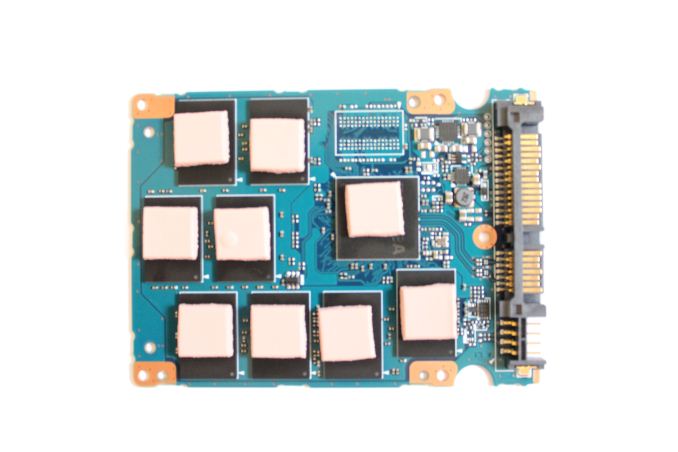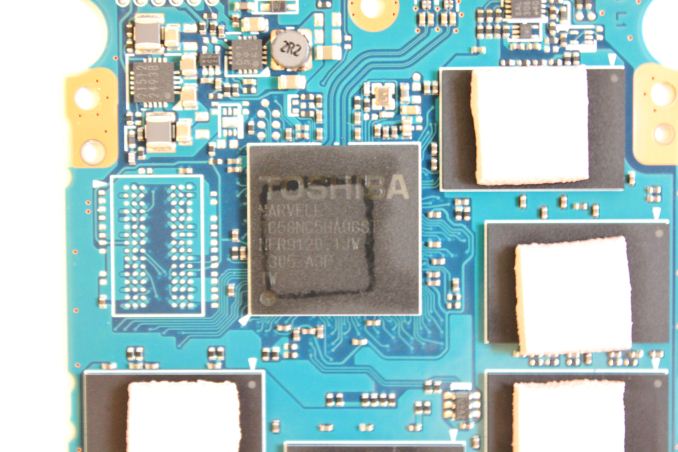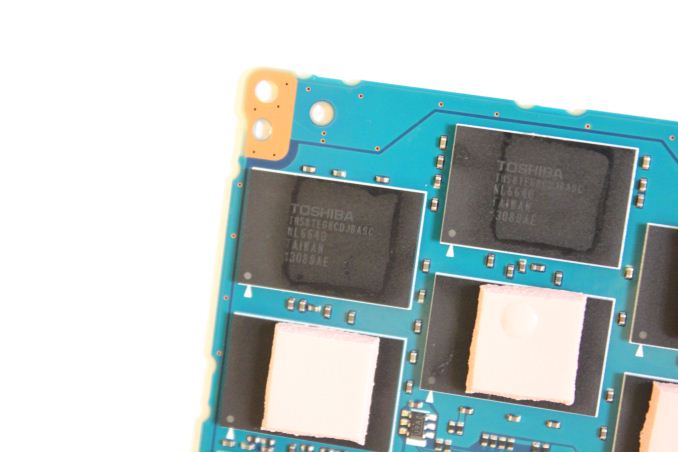Strontium Hawk (240GB) Review
by Kristian Vättö on June 25, 2013 8:00 AM ESTInside The Drive
All major chips are covered by pink thermal pads for heat dissipation. The interesting thing about the controller is that while it's based on Marvell silicon, it does not require any external DRAM. One of the reasons why SSD OEMs have preferred SandForce controllers is that they require no DRAM, which helps to drive costs down. The DRAM is mainly needed for caching the NAND mapping table, although some manufacturers also use it to cache writes, but it's certainly possible to build a design that doesn't require any external DRAM. Especially if you have access to the silicon (like I suspect Toshiba does; this doesn't seem like an off-the-shelf Marvell controller), you can make sure the controller has sufficient built-in caches to eliminate the need for DRAM. What's odd is that there is, however, an empty socket for DRAM next to the controller. It seems that either some models come with additional DRAM (bigger capacities may require a larger NAND mapping table) or the PCB design was simply finalized before the controller/firmware. I asked Strontium about the lack of DRAM but unfortunately they didn't have any knowledge of its purpose as it's purely a Toshiba/Marvell design.
As for the NAND, there are eight packages and each package is 32GiB (4x8GiB) in size.
Test System
| CPU | Intel Core i5-2500K running at 3.3GHz (Turbo and EIST enabled) |
| Motherboard | AsRock Z68 Pro3 |
| Chipset | Intel Z68 |
| Chipset Drivers | Intel 9.1.1.1015 + Intel RST 10.2 |
| Memory | G.Skill RipjawsX DDR3-1600 4 x 8GB (9-9-9-24) |
| Video Card |
XFX AMD Radeon HD 6850 XXX (800MHz core clock; 4.2GHz GDDR5 effective) |
| Video Drivers | AMD Catalyst 10.1 |
| Desktop Resolution | 1920 x 1080 |
| OS | Windows 7 x64 |
Thanks to G.Skill for the RipjawsX 32GB DDR3 DRAM kit













26 Comments
View All Comments
karasaj - Tuesday, June 25, 2013 - link
Every time I kept reading that, I kept thinking about how no name suppliers would be bad... hard to remember it's from Toshiba, haha. Good luck to them. Nice review :) Power consumption seems obnoxiously low at load.mcveigh - Tuesday, June 25, 2013 - link
Strontium Hawk is the name of my spirit animal!jmke - Tuesday, June 25, 2013 - link
not the best product name I must admit... might not do well in Benelux ;)http://translate.google.com/?hl=en#nl/en/stront
Pessimism - Tuesday, June 25, 2013 - link
Why poo-poo the manufacturer for taking a stand to end the 1000^3 garbage? Everyone should follow suit and label with formatted capacity.hedleyroos - Tuesday, June 25, 2013 - link
Your use of the word "poo-poo" is ironically funny to people who speak Afrikaans (and probably Dutch and Flemish) since "stront" means "poo". They have zero chance of succeeding in those markets.Kristian Vättö - Tuesday, June 25, 2013 - link
Like I said, it's pretty much useless for a small OEM like Strontium to try and change the industry.piroroadkill - Tuesday, June 25, 2013 - link
It should then say 240GiB...dealcorn - Tuesday, June 25, 2013 - link
OK. Laptops outsell desktops and you were unable to test with HIPM and DIPM enabled and no mention was made of DEVSLP support which is a big deal for any Haswell mobile device. By impairing the relevance of the review to typical use cases, someone properly earns a demerit.You need a Haswell mobile device to test with if you want to maintain relevance to the mainstream market. I would complain to my bosses that you need better hardware support to perform at the level they and readers expect of you.
Kristian Vättö - Tuesday, June 25, 2013 - link
I'll be brutally honest here. Just because we are AnandTech doesn't mean that we have piles of laptops laying around, especially ones that are based on a chip that was released less than a month ago. All reviewers want Haswell-based devices at the moment, the supply is extremely tight. Usually laptops only have a review time of two weeks or so because the same system may be sent to others once it's been returned. Obviously reviewers who are actually going to review the system are the first priority, so it'd be really hard for me to get one because 1) I would only be using it for one test 2) I couldn't send it back anytime soon. In other words, the manufacturer wouldn't get much bang for their marketing $ because they wouldn't get much visibility, which is the reason review samples exist in the first place.I know there's the option of buying one but again, I'll be honest here: It would be around $1000 for just one test. I would definitely take one if Anand paid for it but as far as I've understood, Anand isn't into spending thousands on test equipment (keep in mind that the financial situation isn't all that good for us since it's usually the marketing budgets that get cut when bad times hit, so it's harder for us to get advertisers). There's a ton of stuff I'd love to have as they would really take our SSD tests (especially power related) to a next level but I'm not the one making decisions.
We have talked with Intel and ASUS and asked if there's anyway HIPM/DIPM could be enabled on a desktop system (even via custom firmware) but as far as I know, they are not up for that.
Trust me, I would take a Haswell laptop on a heartbeat if someone gave me one, but I hope you also understand that we don't get whatever we want from manufacturers.
dealcorn - Tuesday, June 25, 2013 - link
Well handled and responsive to my concern. So, BK is telling his team we have a winning hand but we need to release products faster. Anandtech is arguably the premier web site consumers turn to for help understanding how new technology benefits them. Intel, however, makes no effort to ensure you have access to the hardware necessary to explain why consumers should value the new stuff. If Intel is trying to increase the cadence, they should step up their game. If Intel does not understand that, it lessens BK's credibility.